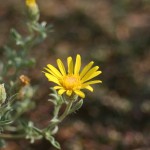Gray Goldaster, Gray Golden-aster, Hoary False Goldenaster
Heterotheca canescens (DC.) Shinners
Asteraceae (Sunflower Family)
Description
A common plant throughout most of Texas, Gray Goldaster is an aggressive perennial of the Sunflower family. It is a bushy, much-branched plant, generally reaching 4 to 18 inches or 10 to 46 cm tall. It has a taproot and is frequently rhizomatous. The leaves are numerous and crowded along the plant stems. Leaves are simple, alternate, and linear to lanceolate. Lower leaves are stalked while upper leaves are sessile and may clasp upward. Leaves are typically 5 times longer than wide and grayish green in color. The upper leaves and inflorescence are silky with soft, silvery-white hairs. Because of the extremely dense hairs on its leaves, Gray Goldaster is difficult to control with herbicides. The yellow flower heads occur at each branch's terminals (ends) and are 3/8 to 5/8 inch in diameter, blooming from July through September. The flower heads are top-shaped to cylindric. Bracts overlap, and margins are rough. There are less than 20 ray flowers about ⅓ to ¼ inches long. Disk florets are about ¼ inch long, with yellow corollas. The achenes are slightly flat, tipped with bristle-like scales and inner hair bristles enclosing a small seed. The forage value of Gray Goldaster is poor for livestock and fair for wildlife.Habitat
Gray Goldaster is found in sandy and gravelly prairies and rock outcrops. It is a common roadside wildflower that grows in colonies. This species can be found in Kansas, Missouri, New Mexico, Oklahoma, and Texas.Images
Plant Characteristics
Flower Color: Yellow
Seed Type: Achene
Duration: Perennial
Stem Texture: Hairy
Growth Habit: Forbs/Broadleaf
Leaf Shape
 : Simple with Pinnate or Parallel Venation
: Simple with Pinnate or Parallel Venation
Season: Warm
Distribution
 : 02 - Gulf Prairies and Marshes, 04 - Blackland Prairies, 05 - Cross Timbers and Prairies, 06 - South Texas Plains, 07 - Edwards Plateau, 08 - Rolling Plains, 09 - High Plains, 10 - Trans-Pecos
: 02 - Gulf Prairies and Marshes, 04 - Blackland Prairies, 05 - Cross Timbers and Prairies, 06 - South Texas Plains, 07 - Edwards Plateau, 08 - Rolling Plains, 09 - High Plains, 10 - Trans-Pecos
Distributions
Distribution refers to the ecological region in Texas that a plant has been found. You can also view a clickable map.
Book: Brush and Weeds of Texas Rangelands (B-6208)
Collection: Brush and Weeds, Wild Flowers





